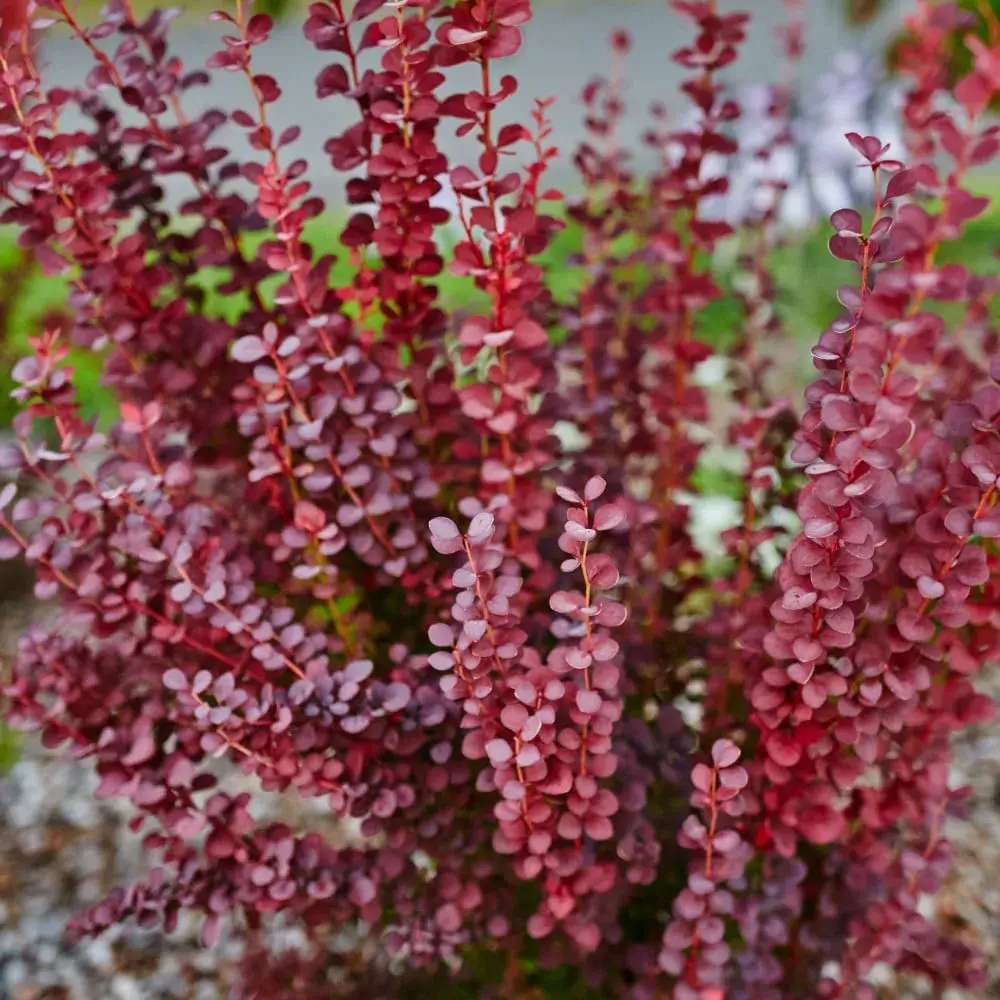Family: Barberry
Type: Shrub

The Crimson Pygmy Barberry stands out with its vibrant, deep red foliage. Compact in size, it’s a popular choice for adding color to gardens.
This deciduous shrub thrives in full sun, enhancing its rich hue. It’s also known for its drought tolerance, making it a low-maintenance option.
The plant’s dense, thorny branches provide excellent security barriers. Despite its prickly nature, it remains a favorite for its aesthetic appeal.
Hardiness Zone: 4a-8b
Deer Resistant: Yes
Pet Friendly: Yes
Moisture Preference: Dry to moist
Sun Needs: Full sun to partial shade
Drought Tolerance (Xeriscape): Yes
Growth Rate: Medium
Average Height (feet): 2
Average Spread (feet): 3
Average Life Span (years): 20
Form: Round
Flower Color: Yellow
Bloom Season: In mid spring
Foliage Color: Red
Leaf Fall Color: Red
Foliage Shape: Oval
Bark Color: Brick red
Bark Texture: Rough
Incorporate Crimson Pygmy Barberry for a splash of color in your landscape. Its small size makes it perfect for borders and foundation plantings.
Pair it with contrasting plants for a dramatic effect. Light green or silver foliage plants complement its deep red leaves beautifully.
This barberry variety also works well in rock gardens. Its texture and color add depth and interest to such landscapes.

In a cottage garden setting, the Crimson Pygmy Barberry adds structure and color. Its bold hue contrasts nicely with soft, flowing perennials.
For modern gardens, this plant offers a touch of elegance. Its compact form and striking color are perfect for minimalist designs.
In Japanese gardens, the Crimson Pygmy Barberry provides a vibrant contrast. Its form and color complement traditional elements like stones and water features.
Use it as a focal point in small garden spaces. Its distinctive color draws the eye, making it a standout feature.
Consider using it in container gardening. It’s well-suited for pots, adding a pop of color to patios or balconies.
Create a low hedge for defined garden sections. Its compact growth habit makes it ideal for creating neat, structured lines.
Select our pre-made garden layouts to create a landscape that’s uniquely yours. Simple, smart, and customizable!
In spring, the Crimson Pygmy Barberry's new foliage bursts into a bright red. This fresh growth adds vibrancy to the garden after winter.
During summer, its leaves deepen to a rich crimson. The plant maintains its color intensity, even in the heat of summer.
In fall, the foliage may turn to shades of orange and red. This seasonal change adds a new dimension to the garden's color palette.
In winter, the plant loses its leaves, revealing a thorny, architectural structure. This provides visual interest in the otherwise barren landscape.
Crimson Pygmy Barberry thrives in areas with full sun to partial shade. It’s ideal for open spaces or garden edges where it can receive ample sunlight.
Full sun is crucial for the best color development of this plant. It can tolerate partial shade, but its vibrant red foliage might not be as pronounced.
This barberry prefers well-drained soil. It's adaptable to various soil types, including clay, loam, or sandy soils, as long as they are not waterlogged.
Space plants about 2-3 feet apart. This spacing allows each plant enough room to grow fully while creating a continuous hedge or border.
The best time to plant is in early spring or fall. Cooler temperatures help the roots establish without the stress of extreme heat or cold.
Dig a hole twice the width of the root ball and the same depth. Place the plant in the hole, fill with soil, and water thoroughly to settle the roots.
Water regularly during the first growing season to establish a deep root system. Once established, it’s drought-tolerant, requiring less frequent watering.
Apply a balanced, slow-release fertilizer in early spring. This supports healthy growth without encouraging excessive foliage that could weaken the plant.
Prune in late winter to maintain shape and size. Remove any dead or damaged branches to encourage healthy new growth.
In spring, remove any dead branches. Apply mulch to retain soil moisture and control weeds.
During summer, ensure adequate water during dry spells. Monitor for pests and diseases, treating as necessary.
In fall, reduce watering as the plant prepares for dormancy. No additional fertilization is needed during this time.
Winter care is minimal. The plant is dormant, so avoid pruning or fertilizing during this period.
Crimson Pygmy Barberry grows moderately, about 1-2 feet per year. It reaches its full size in 2-3 years, making it a quick option for filling spaces.
In some regions, Crimson Pygmy Barberry can be considered invasive. Check local guidelines before planting and manage growth through regular pruning.
Yes, their thorny branches and texture make them less appealing to deer. This makes them a great choice for areas with high deer activity.
Sign up below to get exclusive deals, discounts, and new plant collections—delivered straight to your inbox! Plus, stay inspired with the latest gardening tips, landscaping trends, and DIY garden ideas. Start growing with us today!
A big thank you for subscribing to the PBN Design newsletter.
We're thrilled to have you join our community. Get ready for exciting updates, insightful content, and more delivered straight to your inbox.
Stay tuned!
Go backA big thank you for subscribing to the PBN Design newsletter.
We're thrilled to have you join our community. Get ready for exciting updates, insightful content, and more delivered straight to your inbox.
Stay tuned!
Go back